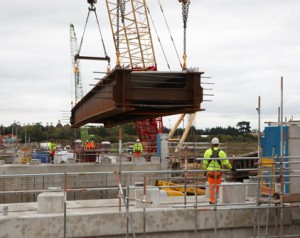 Bridge taking shape as project approaches one year mark
Bridge taking shape as project approaches one year mark
Work is progressing on a major bridge construction project in Chelmsford which started in January 2015 and is scheduled to complete in the winter of 2016. The concrete supports are now in place and as of October 2015, eight massive steel beams (pictured) weighing 52 tonnes have been put in place to form the new bridge’s deck.
What work is involved?
The £28 million bridge on the A138, designed to replace the present viaduct over the river Chelmer which dates back to the 1930’s, will meet traffic loads far in excess of levels the original structure was designed to cope with.
The new bridge will be of three lane construction as opposed to the existing viaduct’s two, and incorporates comprehensive foot and cycle connections. While the new bridge is being built, the present one continues to carry traffic and will be demolished once the new structure is operational.
Minimising disruption
Back in 2007, when consultations were undertaken regarding the future of the Chelmer viaduct, the decision to replace rather than repair and renovate the present structure was made to reduce the disruption of repairing or reinforcing the old bridge.
If repairing, then huge traffic disruption would likely have resulted for an extended period while work was underway, whereas the replacement option means disruption is minimised. Indeed, there is generally no need for any roadworks, traffic management or diversions as construction is taking place alongside the present viaduct which remains in use.
Major parts of the project take place at night, which is why you may not have seen much happening when you cross the bridge during the day. When the huge steel beams mentioned above were delivered on site, rather than causing traffic disruption during busy daylight hours, they arrived at night when conditions were quieter.
Construction type
The project was awarded to GRAHAM Construction, a construction company headquartered in Northern Ireland and dating back nearly 240 years. They have many major construction projects to their name.
The 400 metre long viaduct structure is being constructed of weathering steel with a concrete deck on elliptical columns. The actual river bridge will also feature weathering steel beams with a concrete arch, and the bridge incorporates a more unusual concrete construction in Essex, which that includes an engraved stone inlay for aesthetic purposes.
GRAHAM Construction pledged at the outset of the project to work with local subcontractors and suppliers. Alan Bill, managing director of GRAHAM Construction, told Highways Magazine: “Throughout the duration of this project we, as we do on all of our contracts, will work with the local supply chain and use subcontractors and suppliers from across the region as well as engaging with the local community to ensure there is minimal disruption during the course of this project.“
Main benefits
Along with attending to the deteriorating condition of the present viaduct, the new structure will alleviate slow moving traffic flows towards the Army and Navy. In short, it meets traffic demands that have grown over the decades.
Environmental considerations
Amongst the heavy engineering of the project, environmental issues form a significant part of the process:
Landscaping and planting
Landscaping and planting will be used to screen the parts of the viaduct. The river bridge will a stone inlay incorporating some type of artwork set against a cream coloured concrete in the interests of aesthetics.
Water management
There is careful handling of excess water using drainage ponds to manage flows and remove pollutants before it enters watercourses, and the general design so as not to impede water flow and risk flooding elsewhere.
Noise and lighting
A low noise material will be used for the new road surface, and low-spill lighting will avoid light pollution in the surrounding area.
Ecological
Several species of wildlife, including protected varieties, have been identified in the area, so careful maintaining and restoration of their habitat will be in force during and after construction.
Find Our More About the New Bridge:
- http://hardyservices.co.uk/news/john-graham-given-20m-chelmer-bridge-replacement/
- http://www.itv.com/news/anglia/2015-01-26/major-improvement-work-for-the-a138-chelmer-viaduct-to-start-in-essex/
- https://www.gov.uk/government/news/major-improvement-work-for-the-a138-chelmer-viaduct-to-start-in-essex
- http://www.highways.gov.uk/roads/road-projects/a138-chelmsford-replacement-of-chelmer-viaduct/
- https://www.graham.co.uk/bridge-milestone-for-chelmer-viaduct
- http://highwaysmagazine.co.uk/work-on-chelmer-viaduct-begins/
